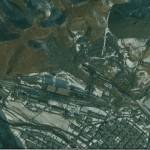After two months, an exhibition in Moscow of North Korean graphics, mosaics and embroidery is coming to a close. Oddly entitled “And Water Flows Beneath the Ice”, the exhibition was a major project initiated and hosted by Russian entrepreneurs at the trendy Winzavod Gallery, a revamped wine factory in central-eastern Moscow.
All the pictures came from the Mansudae Art Studio in Pyongyang, a government-run enterprise that employs more than 1,000 artists to create art for export.
The late (and eternal) North Korean president, Kim Il-sung, is known to have once said, “Abstraction in art is death,” leaving no choice for North Korean artists but to embrace socialist realism as their method.
Russians, who still remember when this artistic trend was the only one permitted by the Communist Party, were given a chance to refresh their memory exactly 20 years after the collapse of the Soviet Union. It is no surprise that many felt a sense of familiarity and at times nostalgia for while visiting the unusual exhibition.
During a short trip to Moscow last month, I met with colleagues, Russian scholars and researchers of Korean studies at the exhibition. They came along with their students, and we had a lively discussion about the hidden messages and artistic value of each picture. It was good to share opinions on a contentious topic such as North Korean art, and our feeling converged on many things regarding the commonalities and differences between North Korean and Soviet propaganda art.
First of all, socialist realism in art is a misnomer, since it depicts life as it should be, not as it really is. For instance, in this exhibition, there was an image of chubby children in Pyongyang Zoo feeding monkeys with ice-cream. The abundance of rice, vegetables and rabbits on show in other pictures also seemed a disservice to aid agencies diligently dispatching food and other humanitarian relief to starving North Koreans. In the artwork, life in the Democratic People’s Republic of Korea was consistently depicted as affluent and pleasant.
In fact, North Korea is a revolutionary state, struggling to achieve economic success and advance its military power. This can be viewed and sensed through the canvases dedicated to the heroism of builders working on the Taegyedo Tideland Reclamation Project or soldiers engaged in constructing the Huicheon Dam.
Heroism at war and in peaceful reconstruction is venerated and equated to the revolutionary course of juche (national self-reliance) and songun (military-first) politics. Thus, every picture, embroidery and poster carries a condensed revolutionary message that must convince the viewer that the people of North Korea are determined and invincible. Some may call it propaganda, but in North Korea this genre is known as Chosunhwa (Korean painting).
In fact, there is very little of Korean tradition in Chosunhwa. Although most pictures are created with watercolors and ink, the characters, actions and settings are Stalinist Soviet or Maoist Chinese. Even where the North Korean artists try to be experimental and use such materials as gouache or mosaic, the results resemble the typical posters and murals once omnipresent in the streets of Moscow and Beijing.
Only the embroidery works were genuinely traditional, and most viewers were stunned by their elaborate composition and vibrant range of colors.
After discussing the merit of each exhibit, my expert friends and I agreed that totalitarian societies do produce impressive pieces of art, which inspire awe and overwhelm the target audience.
While the value of such art is transient and more akin to propaganda, the technical side of it is so unquestionably powerful that it deserves recognition and research, if not admiration.
Unfortunately for the North Korean artists and Mansudae Art Studio entrepreneurs, the value of this art is restricted by the willingness of the purchaser to help the juche and songun revolution. Otherwise, mainstream North Korean art, which is dutifully devoid of abstraction, has very limited export value.
That explains the usual commercial difficulties encountered by the North Korean art exhibitions brought overseas by the North Korean Committee for Cultural Relations with Foreign Countries. Among the rare buyers of the socialist kitsch are maverick revolutionary zealots and some rich sympathizers from South Korea.
In Russia and China, former communist patrons of North Korea, the appetite for hackneyed images and themes is dwindling. What leaves the strongest impression from “The Water Flows Beneath the Ice” is not the contrived propaganda on the walls but the artistic installation placed in the middle of the gallery.
Dozens of green combat helmets hanging from the ceiling form perfect lampshades over the scarlet-red carpet hosting a lonely short-legged Korean traditional table. A bowl of white rice on the table symbolizes the prosperity that songun was designed to create and protect. The soft pink light gleaming from each helmet resembles the cherished hope of the Korean people for peace, love and harmony.
The bouquets of colorful firework shots projected on the screen at the end of the gallery hall surmount the composition and instill a sense of triumphant fulfillment. The aim is seemingly to capture the unbending spirit of Koreans (in both the North and South), as well as their hardworking and peace-loving character.
Overall, the “And Water Flows Beneath the Ice” was a bright and memorable phenomenon for the cultural life of the Russian capital. Neither the awkwardness of the premises (conditions in the old liquor factory demanded that all visitors wore clumsy overshoes) nor the overpriced pamphlet (more than US$30) spoiled the positive and inspiring atmosphere.
Although it is commercially and morally questionable as well as kitsch, the unusual initiative has awakened in hardened Russian art-lovers a long-lost belief in fairness and altruism: ideals that are highly valued by Koreans.

